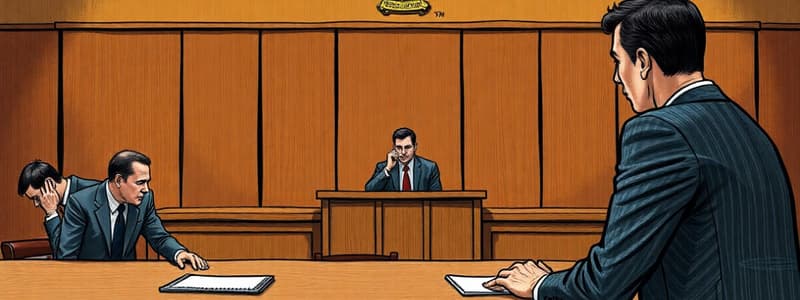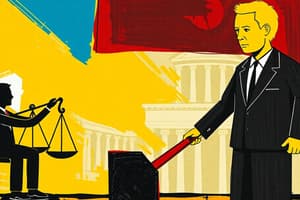Podcast
Questions and Answers
What term describes the release of an accused person from custody before or during prosecution on their promise to appear in court when required?
What term describes the release of an accused person from custody before or during prosecution on their promise to appear in court when required?
- Arraignment
- Bail (correct)
- Detention
- Plea Bargain
What is the primary purpose of an arraignment in the judicial process?
What is the primary purpose of an arraignment in the judicial process?
- To set the bail amount
- To issue a sentence
- To assess the legality of the arrest (correct)
- To determine the defendant's guilt
What is defined as a document that guarantees a defendant's appearance in court and outlines penalties for failure to appear?
What is defined as a document that guarantees a defendant's appearance in court and outlines penalties for failure to appear?
- Indictment
- Bail Bond (correct)
- Plea Agreement
- Subpoena
Which term refers to the collateral used for setting bail in the form of physical property?
Which term refers to the collateral used for setting bail in the form of physical property?
What law aims to prevent the pretrial release of a defendant when they are deemed a danger to the community?
What law aims to prevent the pretrial release of a defendant when they are deemed a danger to the community?
What is the process called where defendants negotiate a plea with the prosecutor and the court?
What is the process called where defendants negotiate a plea with the prosecutor and the court?
What does the defendant's formal answer in court to the charges against them represent?
What does the defendant's formal answer in court to the charges against them represent?
What governs the admissibility of evidence during criminal hearings and trials?
What governs the admissibility of evidence during criminal hearings and trials?
Flashcards
Bail
Bail
The release of an accused person from custody, for all or part of the time before or during prosecution, on their promise to appear in court when required.
Initial Appearance
Initial Appearance
An appearance before a magistrate to assess the legality of an arrest and inform the defendant of the charges.
Bail Bond
Bail Bond
A document guaranteeing a defendant's court appearance, with a pledge of money or property to be paid if they don't show up.
Real Property Bail
Real Property Bail
Signup and view all the flashcards
Danger to Community Law
Danger to Community Law
Signup and view all the flashcards
Plea Bargaining
Plea Bargaining
Signup and view all the flashcards
Plea
Plea
Signup and view all the flashcards
Rules of Evidence
Rules of Evidence
Signup and view all the flashcards
Study Notes
Pretrial Activities and the Criminal Trial
-
Release from Custody: A person accused of a crime can be released from custody, temporarily or permanently, before trial, under conditions set by the court.
-
Initial Appearance: The accused is brought before a magistrate to be informed of the charges against them and their rights. Legality of their arrest is assessed.
-
Bail: Financial security (e.g., land, property, cash) pledged by the accused to ensure they appear in court.
-
Danger to Public: If a judge believes a released criminal defendant poses a risk to others in the community, they may be held.
-
Plea Bargaining: A negotiation between the defendant, prosecutor, and court about an appropriate plea and associated sentence.
-
Formal Answer (Plea): The defendant's official statement to the court about their guilt or innocence.
-
Rules of Evidence: Court rules governing the admissibility (acceptability) of evidence during trials and criminal hearings.
-
Speedy Trial: Federal law that enforces a timeframe (usually within 70 working days) for proceedings to begin after an indictment.
-
Jury Isolation: A jury kept separate from the public during the trial and deliberation process, to prevent outside influences.
-
Jury Selection: The process of choosing a jury.
-
Oral Testimony: A witness’s sworn statement given in court.
-
Evidence: Information/items used to establish the facts of a case. It can be tangible (physical evidence) or intangible (statements - testimony).
-
Evidence Useful for a Judge/Jury: Anything of value in determining the facts of a case.
-
Physical Evidence: Evidence that's tangible and related to a physical event.
-
Direct Evidence: Evidence proving a fact directly, without an inference.
Studying That Suits You
Use AI to generate personalized quizzes and flashcards to suit your learning preferences.



